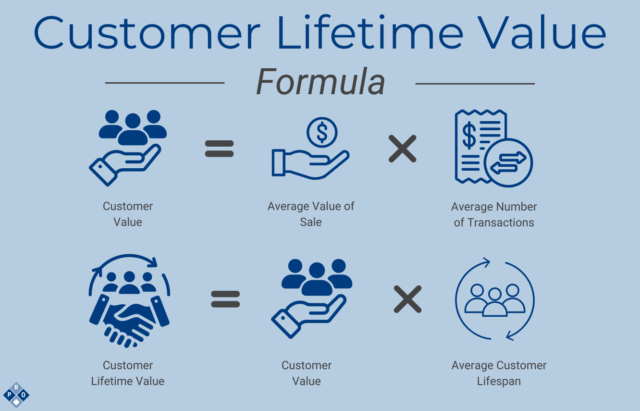Knowing the lifetime value of customers provides valuable insights into how much they can invest in acquiring and retaining customers. By understanding the worth of each customer over the duration of their relationship with the business, owners can make informed decisions regarding their marketing and pricing strategies. In this blog, we will explore the concept of customer lifetime value and its significance in driving business growth and profitability.
What is Customer Lifetime Value?
Customer lifetime value refers to the total worth a customer brings to a business during their entire relationship. It is an essential metric that helps companies determine how much they should invest in acquiring and retaining customers. By understanding the lifetime value of customers, businesses can make informed decisions about their marketing strategies and pricing models.
Customer lifetime value considers factors such as the average sale value, profit margin percentage, frequency of customer purchases, typical customer lifespan, and the number of referrals a customer generates. By calculating customer lifetime value, businesses can assess the affordability of customer acquisition and make strategic decisions accordingly.
Understanding customer lifetime value enables businesses to optimize their resources, allocate budgets effectively, and focus on creating long-term customer relationships. By considering customer lifetime value, companies can maximize their return on investment and ensure sustainable growth and profitability.
Factors to Consider in Calculating Customer Lifetime Value
Customer lifetime value has significant implications for businesses when making strategic decisions. By understanding the affordability of customer acquisition, businesses can allocate their resources effectively and determine how much they can invest in acquiring new customers. This knowledge helps them optimize their marketing strategies and ensure a balanced approach between customer acquisition costs and the long-term value those customers will bring.
Additionally, customer lifetime value plays a crucial role in shaping pricing strategies. By considering the lifetime value of customers, businesses can set prices that align with the value customers bring over time. This ensures that the pricing structure reflects the customer’s worth to the company and maximizes profitability.
Businesses can make informed decisions about resource allocation, marketing investments, and pricing strategies by leveraging customer lifetime value. This approach enables them to drive sustainable growth, optimize return on investment, and build solid and profitable customer relationships.
Ultimately, customer lifetime value is an important statistic that aids in understanding the whole value that a client contributes to a firm over the course of their relationship. Businesses can use the customer lifetime value formula to determine the long-term value of their customers by taking into account variables like the average sale value, profit margin percentage, frequency of customer purchases, typical customer lifespan, and the number of referrals generated. Businesses may decide wisely on marketing expenditures, pricing schemes, and customer relationship management by thoroughly understanding client lifetime value. By utilizing client lifetime value, businesses can generate sustainable development and profitability, maximize their resources, and properly allocate their budgets.
Calculating Customer Lifetime Value
Calculating customer lifetime value is essential for businesses to make informed decisions regarding customer acquisition and retention strategies. By understanding the worth of each customer over their entire relationship with the business, companies can assess the affordability of acquiring new customers and allocate their resources effectively. The customer lifetime value formula considers the average sale value, profit margin percentage, frequency of customer purchases, typical customer lifespan, and the number of referrals generated. This comprehensive calculation provides valuable insights into the long-term value of customers. It helps businesses maximize their return on investment. Companies can drive sustainable growth, optimize pricing strategies, and build strong customer relationships by leveraging customer lifetime value.

Implications of Customer Lifetime Value
Customer lifetime value has significant implications for businesses when making strategic decisions. By understanding the affordability of customer acquisition, businesses can allocate their resources effectively and determine how much they can invest in acquiring new customers. This knowledge helps them optimize their marketing strategies and ensure a balanced approach between customer acquisition costs and the long-term value those customers will bring.
Additionally, customer lifetime value plays a crucial role in shaping pricing strategies. By considering the lifetime value of customers, businesses can set prices that align with the value customers bring over time. This ensures that the pricing structure reflects the customer’s worth to the company and maximizes profitability.
Businesses can make informed decisions about resource allocation, marketing investments, and pricing strategies by leveraging customer lifetime value. This approach enables them to drive sustainable growth, optimize return on investment, and build solid and profitable customer relationships.
Ultimately, customer lifetime value is an important statistic that aids in understanding the whole value that a client contributes to a firm over the course of their relationship. Businesses can use the customer lifetime value formula to determine the long-term value of their customers by taking into account variables like the average sale value, profit margin percentage, frequency of customer purchases, typical customer lifespan, and the number of referrals generated. Businesses may decide wisely on marketing expenditures, pricing schemes, and customer relationship management by having a thorough understanding of client lifetime value. By utilizing client lifetime value, businesses can generate sustainable development and profitability, maximize their resources, and properly allocate their budgets.
Share this Post:




